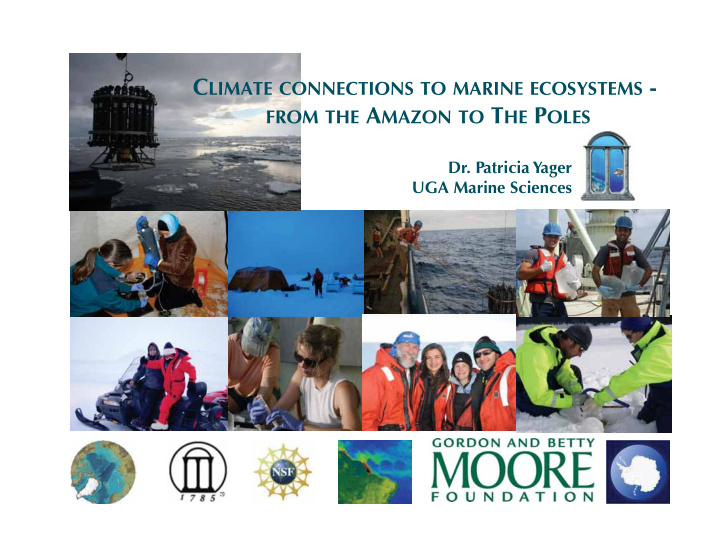



C LIMATE CONNECTIONS TO MARINE ECOSYSTEMS - FROM THE A MAZON TO T HE P OLES Dr. Patricia Yager� UGA Marine Sciences
Climate and the marine biosphere • Temperature • Light availabilty • Nutrients • pH SeaWIFS Aris Multimedia Entertainment, Inc. 1994 Aris Multimedia Entertainment, Inc. 1994
Climate and the marine biosphere • Temperature • Light availabilty • Nutrients • pH Climate-active gases Climate-active gases ( CH 4 , N 2 0, DMS, CO 2 ) ( CH 4 , N 2 0, DMS, CO 2 ) Ocean color effects on albedo Ocean color effects on albedo Ecosystem changes SeaWIFS Aris Multimedia Entertainment, Inc. 1994 Aris Multimedia Entertainment, Inc. 1994
See: Garay&Yager Pumping Carbon activity http://www.polartrec.com/resources/ activity/pumping-carbon
Barrow, Alaska (71°17’N, 156°47’W) Amazon River Continuum (0-12°N, 45-59°W) Amundsen Sea Polynya (72-74°S, 111-115°W)
Why is the Amazon plume taking up so much CO2 from the atmosphere? Is this sink climate sensitive? NASA SeaWIFS NASA
D. Munroe Why is the Amundsen Sea polynya taking up so much CO2 from the atmosphere? Is this sink climate sensitive?
NSIDC How will the loss of sea ice and other climate changes affect the coastal Arctic carbon cycle and food web? W. Kimmerer
Microbial control on the productivity of Barrow's coastal waters - �Will the battle for nitrogen intensify under climate change? Patricia Yager Debbie Bronk Marc Frischer University of Georgia Virginia Inst. Mar Sci Skidaway Inst. Oceanogr.
Arctic Marine Food Web priweb.org http://www.arcodiv.org/
EPA/NASA Sept 2011
How will the loss of sea ice affect the food web? Hypothesis: Reduced benthic? Increased pelagic? Nutrients required! W. Kimmerer
2006 2007 Length of Growing PP Arrigo et al. 2008 season 07 - 06 07 - 06
Nutrients come from the Bering Sea or from upwelling near the shelf break [Courtesy Tom Weingartner]
Yager et al. 2001
Arctic Marine Food Web ? http://www.arcodiv.org/
Nybakken
Food Web Don’t forget to recycle! Detritus (POM + DOM) Decomposers (bacteria etc) Microbial food web Nutrients, CO 2 Nybakken
Adds to the classical herbivorous food web Bacteria in food webs Decomposers Prey for protozoans Infected by viruses
Aren’t bacteria bad? E. coli faculty.mc3.edu/ jearl/ML/ml-7.htm
No – most are needed for healthy ecosystems… Smallest marine organisms: 0.5 μm in diameter (although largest marine bacterium is 750 μm) Three lifestyles: planktonic, attached, symbiotic 2 million per drop (milliliter) of coastal seawater Decomposers Significant metabolic diversity Low morphological diversity
Focus on bacteria as heterotrophs or “decomposers” But also perhaps nutrient consumers????
Marine life responds to physical change Late ice retreat Early bloom Benthic production Early ice retreat Late bloom Pelagic production
NO 3 DOM Light Phyto Bacteria Standard “model”
NO 3 Riverine DOM DOM Light Phyto Bacteria Future scenario?
NO 3 Riverine DOM DOM Dark Winter ? Phyto Bacteria Future scenario?
Hypothesis: Climate change will enhance the competition for N in the coastal Arctic as it reduces sea ice and increases terrestrial organic inputs, without affecting the annual light cycle. These changes will reduce the flux of C to the benthos, and the efficiency of the biological pump.
Seals Whales Birds Higher Squid Fish Trophic Humans Micro Meso Meso Zoo- Zoo- Zoo- Small Large Phyto- Phytoplankton Sinking Particles Bacteria Nutrients Courtesy T. Connelly
Micro Fish Zooplankton Birds Meso Zoo- Small Large Phytoplankton Phyto- Sinking Particles Nutrients Bacteria
Recommend
More recommend